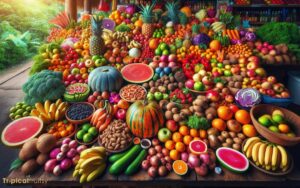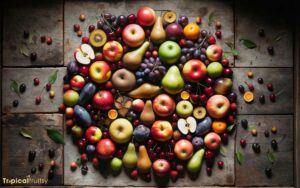Can You Grow Tropical Fruit in a Greenhouse? Explore!
Growing tropical fruits in a greenhouse is indeed possible and can be quite rewarding.
By simulating tropical conditions, such as maintaining high humidity and warm temperatures, enthusiasts and commercial growers can cultivate a variety of tropical fruits far from their native habitats.
To grow tropical fruits in a greenhouse, one must closely regulate environmental factors:
Certain tropical fruit species are more adaptable to greenhouse cultivation than others. For example, dwarf varieties of bananas, pineapples, and papayas are often more suitable due to their size and growth requirements.
Embrace the exotic by transforming your greenhouse into a tropical paradise, teeming with luscious fruits ripe for the picking.
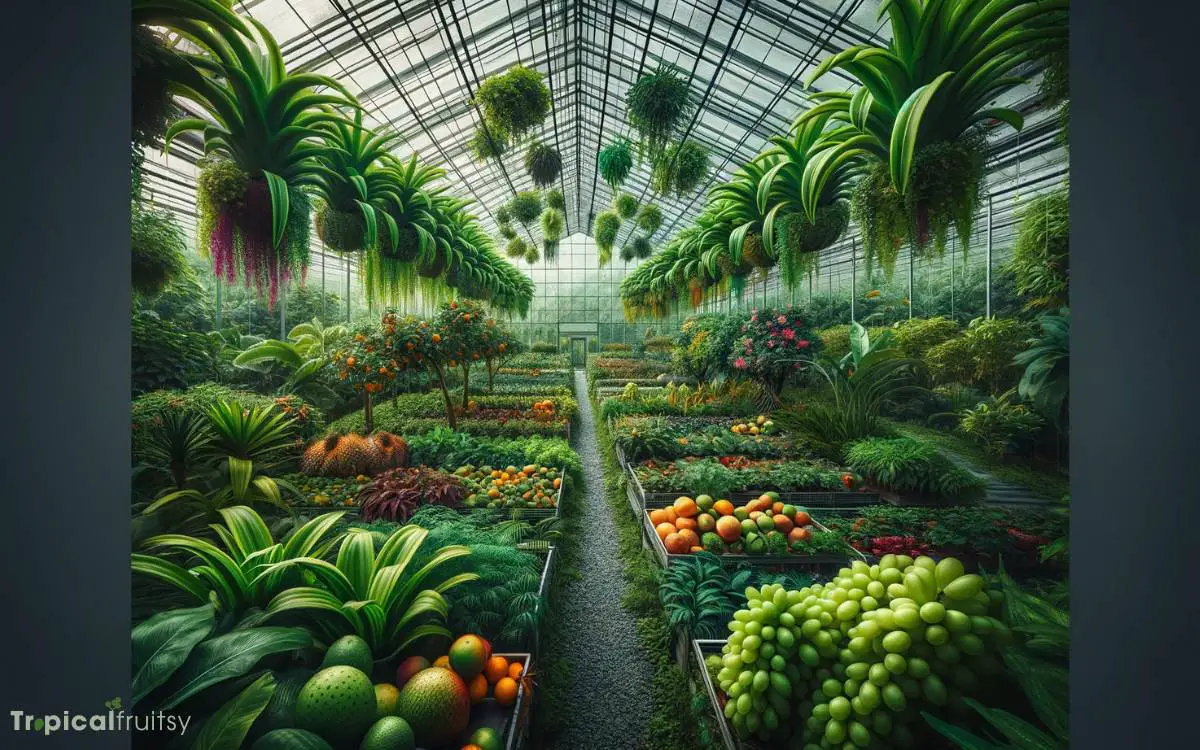
Key Takeaway
7 Factors: Requirement for Tropical Fruits and Notes
| Factor | Requirement for Tropical Fruits | Notes |
|---|---|---|
| Temperature | 65-85°F (18-29°C) | Essential for growth and fruit development |
| Humidity | 75-95% | Mimics the natural tropical climate |
| Light | Adequate natural or artificial | Supplemental lighting may be needed during shorter daylight |
| Ventilation | Proper air circulation | Prevents disease and maintains temperature/humidity balance |
| Soil Type | Well-draining, fertile | Specific soil types may be required for different fruit species |
| Watering | Consistent and controlled | Overwatering can lead to root rot and other issues |
| Fruit Variety | Suitable for greenhouse growth | Dwarf and self-pollinating varieties are often recommended |
Understanding Greenhouse Environments
Understanding Greenhouse Environments is crucial because it frequently determines the success of cultivating tropical fruits in non-native climates.
A greenhouse provides a controlled habitat, where variables such as temperature, humidity, and light can be managed to mimic tropical conditions.
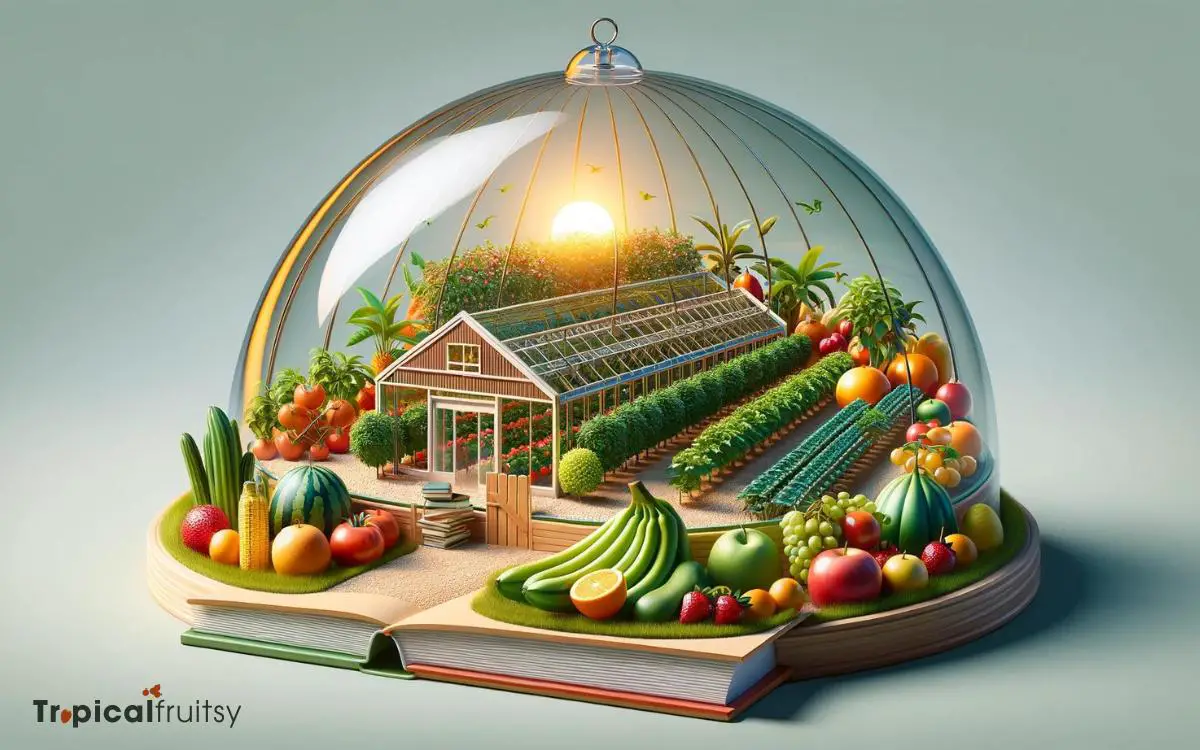
For optimal growth, each species of tropical fruit requires a specific range of temperature, usually between 65°F to 95°F, with relative humidity levels often exceeding 80%.
Advanced greenhouses employ automated systems that regulate these environmental factors through sensors and actuators.
Ventilation is also pivotal to prevent disease and ensure a steady supply of carbon dioxide for photosynthesis.
The choice of glazing material affects light diffusion and insulation, key for maintaining consistent internal conditions.
Precision in replicating tropical climates within a greenhouse is therefore essential for fruitful cultivation.
Essential Tropical Fruit Conditions
To successfully cultivate tropical fruits within a greenhouse setting, it is imperative to replicate their native climatic conditions as closely as possible.
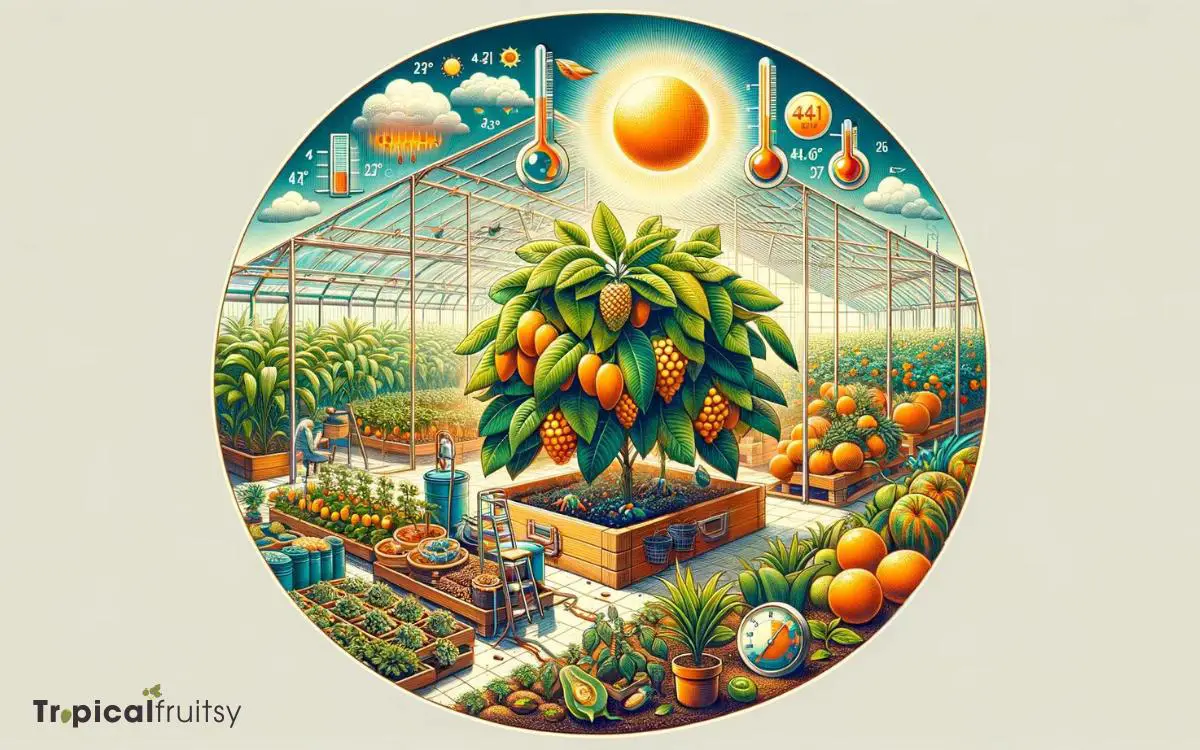
This necessitates meticulous management of humidity levels, often requiring systems that can sustain a high moisture environment to ensure optimal plant growth and fruit development.
Additionally, precise temperature control is crucial, as tropical species typically demand a warm climate with minimal fluctuations to thrive.
Humidity Requirements
Maintaining high humidity levels within a greenhouse is crucial for the successful cultivation of tropical fruits, as these plants typically thrive in environments with at least 60% relative humidity.
To vividly illustrate the conditions necessary to achieve this, consider the following environmental augmentations:
- Automated misting systems that disperse fine droplets of water to elevate moisture levels
- Evaporative cooling pads installed along the greenhouse walls that contribute to ambient humidity
- Water features such as small fountains or ponds that naturally evaporate to increase air moisture
- Retention of soil moisture through mulching or the use of capillary mats
- Regular monitoring with hygrometers to ensure optimal humidity levels are consistently maintained
As the moisture requirements are met, attention must seamlessly transition to regulating thermal conditions, another pivotal aspect of tropical fruit greenhouse cultivation.
Temperature Control
Achieving the appropriate temperature range is as critical as humidity control when cultivating tropical fruits in a greenhouse environment.
Tropical fruit plants typically require a stable temperature between 65°F and 85°F to thrive, with minimal fluctuations.
Advanced greenhouse setups use a combination of heating, cooling, ventilation, and shading systems to maintain this delicate balance.
Heating systems, such as gas or electric heaters, are often employed during cooler months, while evaporative cooling systems or exhaust fans are used to reduce excessive heat during warmer periods.
Ventilation is necessary to dissipate heat and introduce fresh air, which aids in temperature regulation and prevents plant stress.
Automated climate control systems can provide precise monitoring and adjustments to ensure optimal growing conditions, which are paramount for successful fruit production.
Selecting Suitable Tropical Fruits
In the pursuit of cultivating tropical fruits within a greenhouse environment, one must first carefully select species that are well-adapted to such controlled conditions.
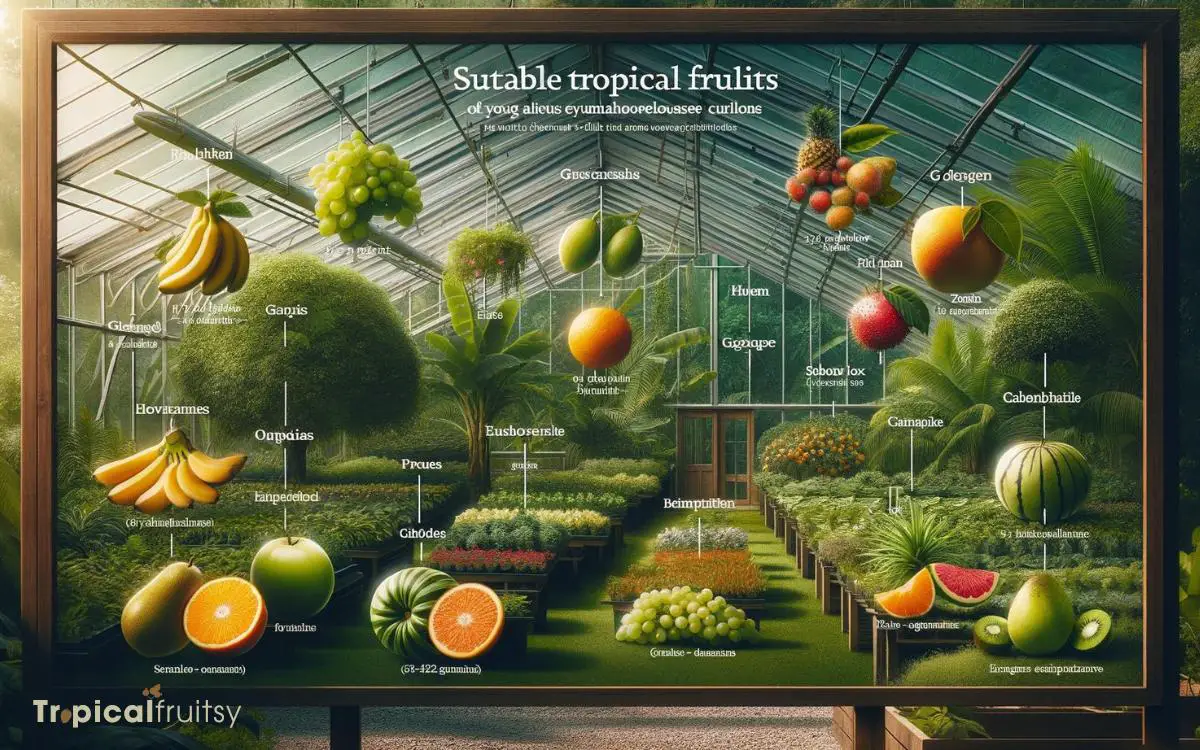
The selection process involves considering factors such as the plant’s mature size, growth habits, and the specific environmental requirements that can be feasibly replicated within a greenhouse setting.
To facilitate this process, here is a list of tropical fruits that generally exhibit compatibility with greenhouse cultivation:
- Dwarf Banana Varieties: Compact and manageable, they thrive in the warm, humid conditions a greenhouse can provide.
- Pineapple Plants: With their tolerance for pot cultivation, they adapt well to the spatial constraints of a greenhouse.
- Papaya: Fast-growing with a propensity for warmer climates, suitable for larger greenhouse structures.
- Passion Fruit Vines: They require structural support but are otherwise well-suited for greenhouse growth.
- Dragon Fruit (Pitaya): Climbing cacti that flourish with controlled temperatures and can be trained on trellises.
Selecting the appropriate varieties within these species is crucial for successful greenhouse cultivation and will significantly influence yield and fruit quality.
Greenhouse Temperature Management
Optimal temperature regulation within a greenhouse is essential for the successful cultivation of tropical fruits.
Maintaining a consistent environment prevents stress on the plants, which can lead to poor growth or fruit production.
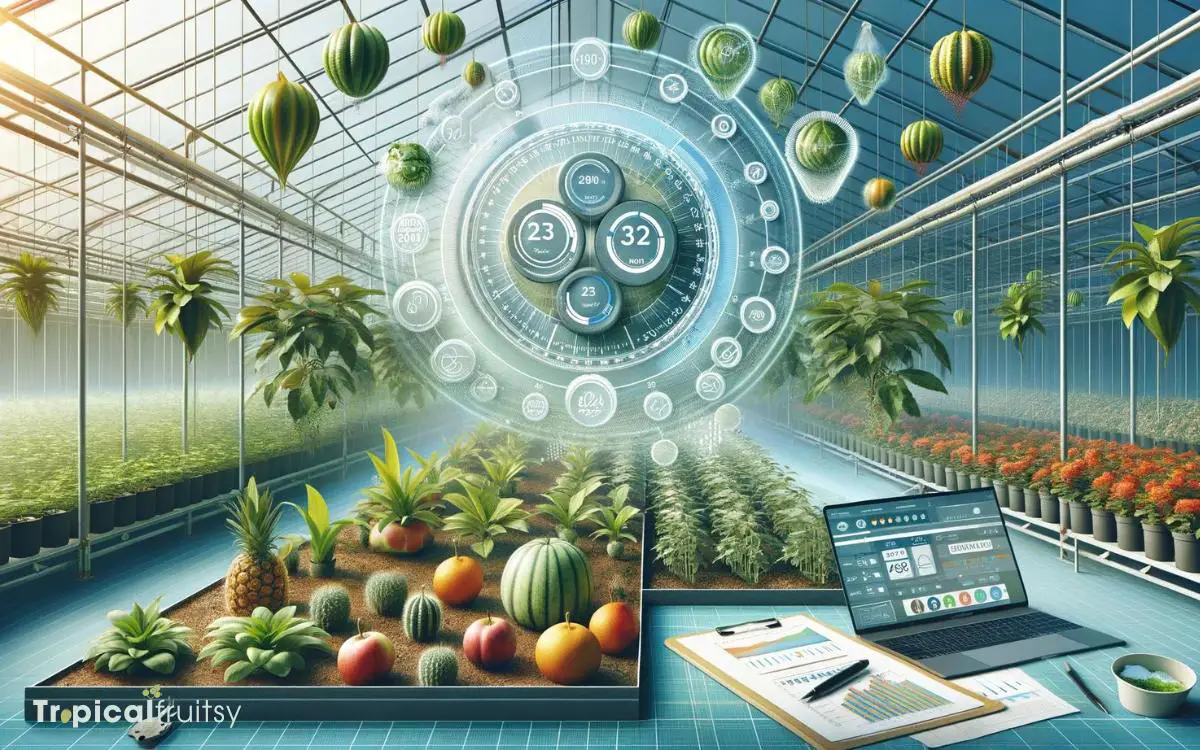
Advanced environmental control systems are often utilized to monitor and adjust the temperature within precise parameters.
These systems can be programmed to emulate the natural diurnal temperature fluctuations that many tropical species require.
| Temperature Aspect | Ideal Range (°F) |
|---|---|
| Daytime | 70 – 85 |
| Nighttime | 60 – 70 |
| Seed Germination | 75 – 80 |
| Fruit Setting | 65 – 75 |
Adequate insulation and ventilation must be balanced to achieve these temperature ranges.
Additionally, employing methods such as heating mats, thermal screens, or fog systems can further refine the microclimate to suit specific tropical fruit requirements.
Humidity and Ventilation Techniques
Beyond temperature control, maintaining appropriate levels of humidity and ensuring effective ventilation are crucial for the health of tropical fruit plants in a greenhouse setting.
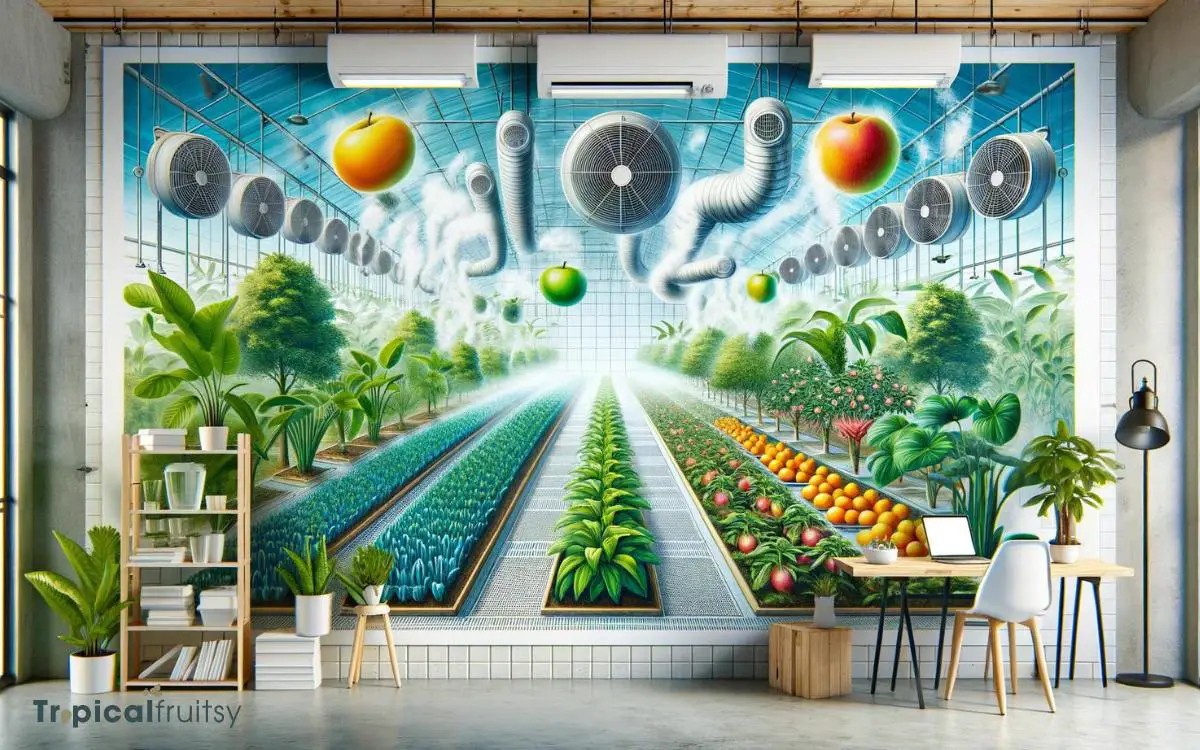
Tropical plants typically thrive in environments with high humidity, which can be challenging to sustain in some climate-controlled greenhouses.
To address this, a range of techniques are applied by horticulturists:
- Utilizing automated misting systems that disperse water vapor at predetermined intervals.
- Installing hygrometers to monitor the precise humidity levels within the structure.
- Implementing exhaust fans and vents that facilitate the exchange of air and control moisture accumulation.
- Employing shade cloths to reduce temperature and evapotranspiration rates.
- Incorporating wet wall systems or evaporative coolers to maintain a consistent humidity level.
These strategies are essential for simulating the natural conditions necessary for tropical fruit cultivation.
Soil and Fertilization Tips
The health of tropical fruit plants in a greenhouse also depends on the careful selection and management of soil and fertilization practices.
Optimal soil composition should mimic the plant’s native environment, often requiring a well-draining medium rich in organic matter. A balanced pH, typically ranging from 5.5 to 6.5, is crucial for nutrient uptake.
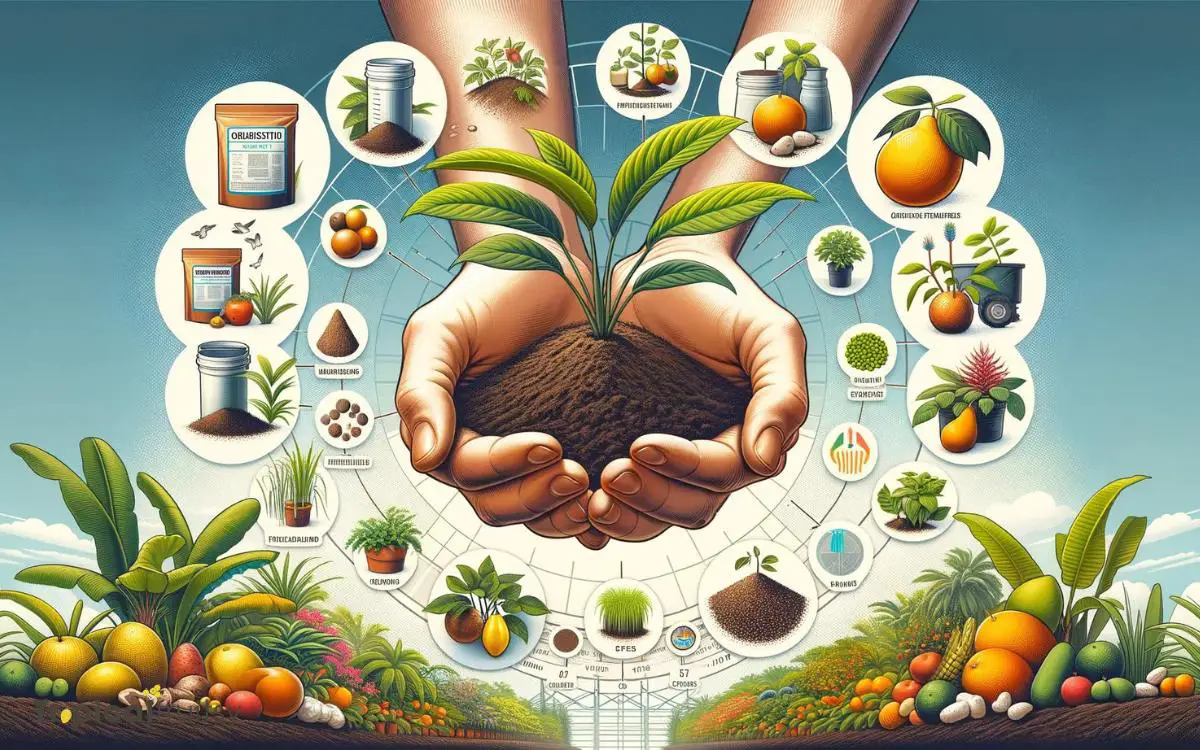
Regular soil testing can guide targeted amendments, ensuring the correct balance of macro and micronutrients.
Fertilization should be strategic; slow-release fertilizers with an appropriate N-P-K ratio support sustained growth, while foliar feeds can address immediate deficiencies. Over-fertilization can lead to nutrient burn, disrupting plant health.
With the foundation of robust soil and fertilization practices established, we must now turn our attention to the common challenges and solutions in growing tropical fruits within a greenhouse setting.
What Are the Best Greenhouse Techniques for Growing Tropical Fruit in Cold Climates?
When it comes to growing tropical fruit in cold climates, using heated soil cables or mats can help maintain the necessary warmth for the roots. Additionally, utilizing thermal mass such as water barrels or rocks inside the greenhouse can help regulate temperature and create a favorable environment for the plants.
Common Challenges and Solutions
Cultivating tropical fruits in a greenhouse environment presents several intricate challenges that require precise solutions.
Effective temperature regulation is critical, necessitating advanced techniques to maintain the consistent warmth that tropical species demand.

Addressing pest control and humidity management is equally essential, involving the implementation of strategic measures to mitigate these common yet impactful obstacles.
Temperature Regulation Techniques
Maintaining an optimal temperature is one of the primary challenges when growing tropical fruit in a greenhouse, requiring precise control mechanisms to simulate native climates.
Effective temperature regulation can involve several technical solutions:
- Automated ventilation systems that open and close to modulate internal temperatures
- High-volume fans for air circulation to prevent hotspots and encourage uniformity
- Shade cloths that can be drawn to protect plants from excessive sunlight and heat
- Evaporative cooling systems that utilize water evaporation for a cooling effect
- Heating systems with thermostatic controls for maintaining warmth during cooler periods
Each technique plays a crucial role in mirroring the delicate balance of a tropical environment.
As growers implement these temperature regulation strategies, an equally systematic approach is necessary for pest control, which will be discussed next.
Pest Control Strategies
Effective pest control is an essential component in the successful greenhouse cultivation of tropical fruits, necessitating the implementation of integrated pest management strategies.
To maintain the delicate balance within a tropical fruit greenhouse, it is critical to identify common pests and devise both proactive and reactive measures to mitigate their impact.
| Pest Type | Challenge | Solution |
|---|---|---|
| Insects | Rapid reproduction and resistance to single-method control | Use of biological controls like beneficial insects, and rotation of organic insecticides |
| Diseases | Spread quickly in warm, humid conditions | Implementation of proper ventilation systems and resistant plant varieties |
| Rodents | Damage to crops and infrastructure | Physical barriers and traps, along with strict hygiene and waste management protocols |
Humidity Management Essentials
Appropriate humidity levels are crucial for the growth of tropical fruits in a greenhouse, where both excess and insufficient moisture can pose significant challenges to cultivators.
To manage humidity effectively, one must understand the intricacies of the greenhouse microclimate.
Strategic humidity control can mitigate issues such as plant stress, pest infestations, and fungal diseases, which thrive in imbalanced conditions.
Here are essential considerations for maintaining optimal humidity:
- Ventilation Systems: Automated or manual, to regulate airflow and reduce condensation.
- Hygrometers: Precision instruments for monitoring humidity levels.
- Misting Systems: To increase humidity during drier conditions, with careful scheduling to avoid over-saturation.
- Dehumidifiers: Essential for extracting excess moisture from the air.
- Shade Cloths: To reduce temperature and slow the rate of evaporation on hot days.
Implementing these solutions requires a balance of technology, observation, and timely intervention to create a conducive environment for tropical fruit cultivation.
Conclusion
The cultivation of tropical fruits within a greenhouse is a feasible venture, provided that careful attention is given to replicating the natural conditions these fruits require.
Although critics may argue that the energy costs associated with maintaining high temperatures and humidity levels are prohibitive, advances in greenhouse technology offer energy-efficient solutions that mitigate this concern.
Ultimately, with appropriate infrastructure and management practices, a greenhouse can become a suitable environment for producing an array of tropical fruits.


